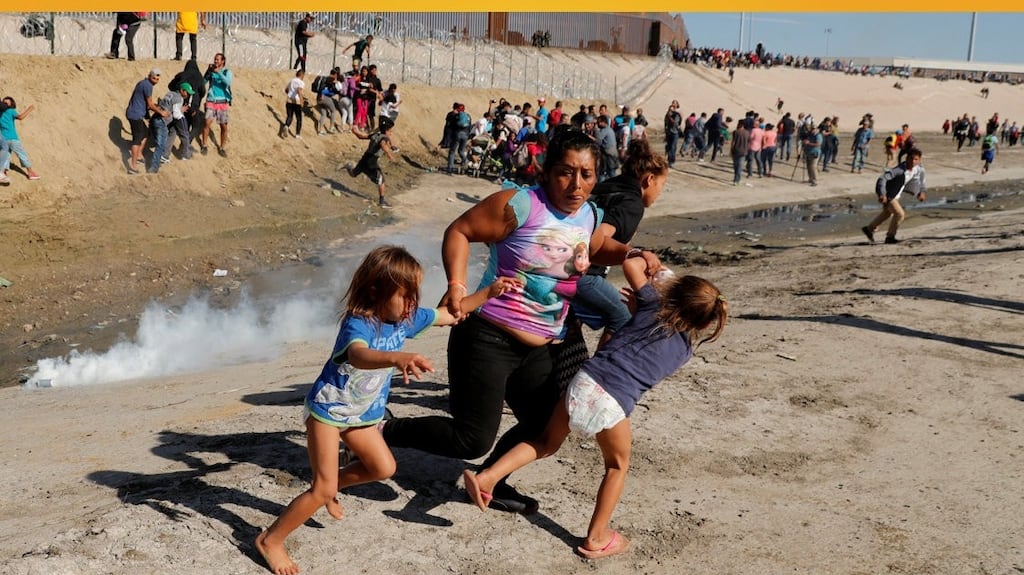Mesmerised by the unpredictability of our times, we wait to see whatever will happen next – and thus do nothing to prevent it. In the state we’re in, the worst possible adage is that seeing is believing.
Do we have to see children being tear-gassed on the US-Mexico border before we believe that a slide into authoritarianism is under way?
Do we have to see images of a sterile, lifeless, pitilessly overheated Mars before we can imagine what we are doing to our own planet?
Do our neighbours in Britain have to actually experience all the suffering before they can believe in the consequences of Brexit?
Do we have to return to sectarian violence on this island before we remember its horror? Do we have to actually see open fascism in Europe before we can grasp its presence as a living possibility?
A country losing touch with its own history is like an old man losing his glasses, a distressing sight, at once vulnerable, unsure and easily disoriented
I keep thinking about two Irish plays. In the epilogue to Bernard Shaw's Saint Joan, John De Stogumber, the priest who helped to have Joan burned at the stake, says that he needed to see the girl die in agony before he understood what he was doing: "I had not seen it, you know. That is the great thing: you must see it. And then you are redeemed and saved."
The bishop, Pierre Cauchon, asks him: “Were not the sufferings of our Lord Christ enough for you?” De Stogumber confesses that they were not, that he had “seen them in pictures and read them in books, and been greatly moved by them, as I thought. But it was no use . . .” He needed to see the suffering with his own eyes. And so Cauchon asks him: “Must then a Christ perish in torment in every age to save those that have no imagination?”
The other play is John Synge's The Playboy of the Western World. It enacts for us the difference between a story and an event. The people in the remote west of Ireland pub are thrilled by Christy Mahon's account – more vivid and dramatic every time he tells it – of how he killed his father.
They find it romantic, sexy, heroic. And then his Da arrives, undead but with a gaping wound in his head.
Christy "kills" him again, this time in front of the same people who have glamorised his great deed. They are sickened and repelled and frightened by it. Christy can't understand this complete turnabout: why did they love him when he described the killing but hate him now that they've seen it. And in Synge's great line, Pegeen Mike tells him why: "There's a great gap between a gallous [ie brave] story and a dirty deed."
Pictures of suffering and disaster
That’s the gap we are in danger of falling into. Are the images, the stories, the pictures of suffering and disaster not enough for us? Do we have to crucify Christ in every generation before we can understand our own capacity for cruelty?
Do we have to commit the dirty deeds before we can be repelled by them? Do we need to experience ever more droughts and storms and floods and wildfires before we acknowledge the extreme urgency of controlling climate change?
We have never been so utterly in need of the historical imagination.
The English Conservative politician George Walden said "A country losing touch with its own history is like an old man losing his glasses, a distressing sight, at once vulnerable, unsure and easily disoriented." And we are now so easily disoriented. We have created, in the digital world, an enormous disorientation machine, a great system for blurring the distinction between the real and the unreal. In its endless present tense, the past fades and the future is blurred.
What can happen
History does not tell us what will happen in the future. But it tells us what can happen. It is our store of concrete possibilities – concrete in the sense that they have actually been realised. If we lose touch with it – or more insidiously turn it into a series of gallous stories – we lose our sense of danger, and there is nothing more perilous than losing your sense of danger. But we also lose something else: the sense that nothing is inevitable.
History tells us what can happen and it also tells us about our collective capacity to avoid disasters if we see them coming. Within it, we get to reimagine the worst so that we don’t actually have to experience it.
The capacity for foresight is what allowed our species to survive and thrive. Unlike other species, we can build and share mental maps of what may happen. Unlike them, we can keep records of what has happened over many, many generations and use them as guides to the landscape of likely consequences.
Yet here we are acting collectively as if we had never developed this unique capacity. Paradoxically, life in a virtual world has made us even more literal-minded: we don’t believe what we have not yet fully experienced.
When you don’t believe what you have not seen, you end up not even really believing what is in front of our eyes. We are seeing the beginnings of dark stories whose endings we can change only if we fully imagine them.









